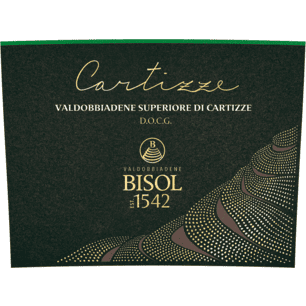
Bisol Prosecco Valdobbiadene Superiore di Cartizze
Grape variety: 85% Glera, 10% Pinot Bianco, 5% Verdiso (Estate Grown).
Color: Brilliant straw yellow with lime-green highlights and a fine and persistent perlage.
Bouquet: wild flowers; balanced intensity; fresh and elegant. Finishes with a pleasant fruitiness.
Flavor: True to the bouquet in its fruity notes of apples and pears; its balance is rounded off by its rich and fine taste.
The Bisol family, whose historic winery is located in Santo Stefano di Valdobbiadene, manages 308 acres of vineyards in the DOCG area, spread over 35 plots in premier locations. The feather in their cap is their seven acres holding on the summit of the Cartizze hill, the most precious vineyard in Italy.
Bisol pursues the highest levels of quality and seeks to elevate the notoriety of the entire Valdobbiadene appellation. Their integrated approach to production begins with a careful selection of vineyards and continues with direct management of each phase of viticulture and vinification right up to the final bottling. The owners of some of the steepest hills in the area, Bisol’s vineyards are worked by hand and cared for using sustainable techniques. Sitting on the cutting edge of tradition, Bisol continuously studies the best techniques for this historic region. Each year the family tests at least six new vinification techniques in order to better understand this unique terroir.

Explore a World of Spirits and Liquor through our Comprehensive FAQ Section.
Discover a World of Spirits and Liquor in our Helpful FAQ Section.
Types of Spirits
- Whiskey: Made from fermented grain mash and aged in wooden casks.
- Vodka: Typically distilled from grains or potatoes and known for its clear, neutral flavor.
- Rum: Produced from sugarcane byproducts like molasses or sugarcane juice.
- Tequila: Made from the blue agave plant, primarily in the area surrounding Tequila, Mexico.
- Gin: Distilled with botanicals, primarily juniper berries, giving it a distinctive flavor.
Production Process
- Fermentation: The process where yeast converts sugars into alcohol.
- Distillation: Separating alcohol from the fermented mixture to increase its concentration.
- Aging: Storing spirits in barrels to develop flavors over time.
Tasting and Pairing
- Tasting Notes: Learn to identify different aromas, flavors, and textures.
- Food Pairings: Discover which spirits complement various dishes, enhancing the dining experience.
Cocktails and Mixology
- Classic Cocktails: Recipes and techniques for making popular drinks like the Old Fashioned, Martini, and Mojito.
- Mixology Tips: How to balance flavors and create your own cocktail recipes.
History and Culture
Origins: The historical background of different spirits.
Cultural Significance: How spirits are enjoyed and celebrated around the world.

